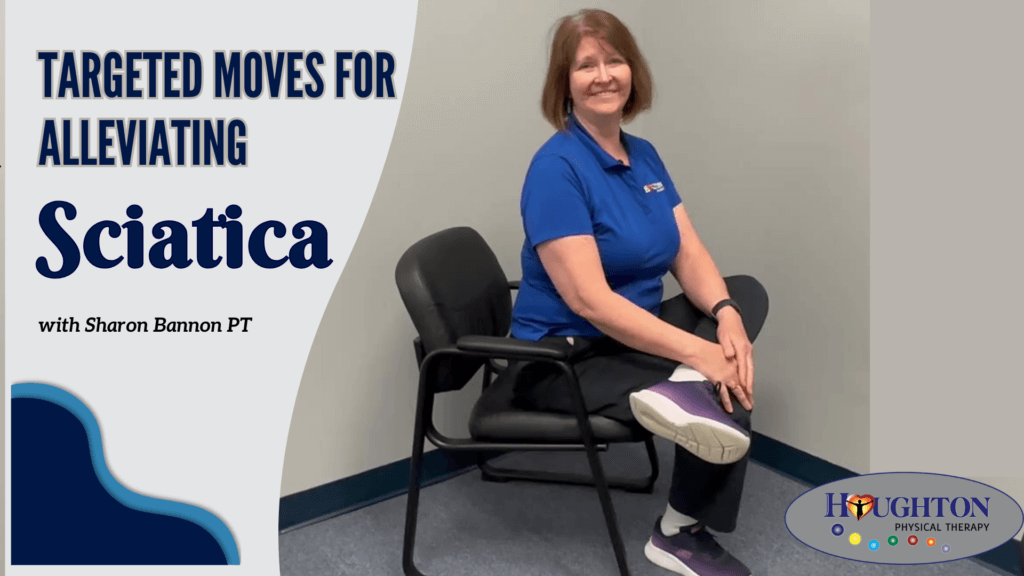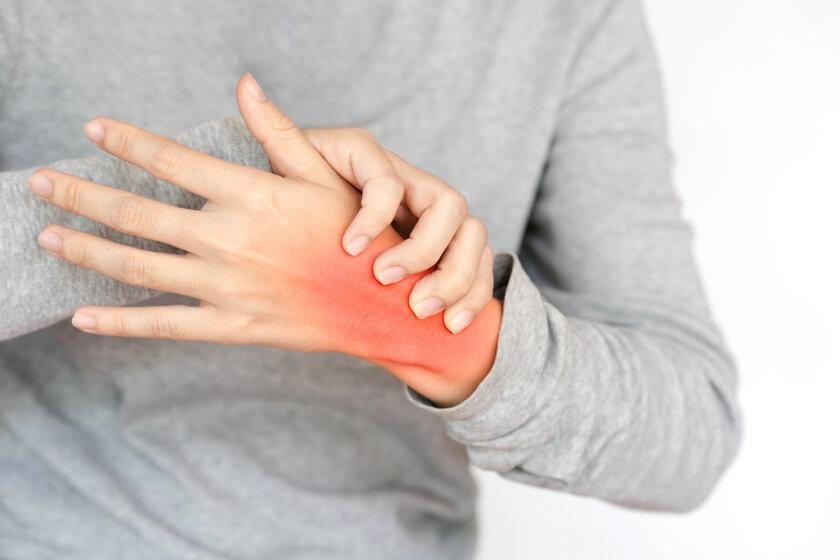Temporary Troubles or More? Understanding the Nature of Sciatic Pain
Well, we’ve had the privilege of interviewing Sharon Bannon, a brilliant and dedicated Physical Therapist here at Houghton PT, who has a treasure trove of invaluable tips and a wealth of information waiting for you to explore. So, dive right in and enjoy the insights!
Have you ever found yourself pondering the enigma of sciatic pain? You’ve likely overheard friends and acquaintances grumbling about it, but let’s take a deeper dive into the world of sciatica. Sciatic pain is a term often used to describe any discomfort that journeys from your back down to your leg. Imagine this: the sciatic nerve embarks on a journey from your lower back at level L3-4 and L4-5, making its way through your buttock, down the outer side of your leg, all the way to your foot. It’s a fascinating journey, and Sharon’s insights can shed light on its intricacies.
Now, here’s the interesting part – anything that hinders this nerve’s path can lead to sciatic pain. Whether it’s a lumbar disc bulge, a narrowing of the nerve space (also known as stenosis), muscle tightness or spasm in the piriformis muscle, or even a misalignment in the sacroiliac joint within your pelvis, these culprits can trigger those unwelcome sensations. But don’t worry, we’re here with Sharon to shed light on sciatic pain and help you better understand what’s happening in your body. So, let’s embark on this informative journey together!
Exploring Leg Pain: Causes and Age Factors for Sciatic Nerve Discomfort
Leg pain can be elusive, as it’s often a symptom of various issues. If you’re experiencing leg pain stemming from your sciatic nerve, you might feel it in your calf and toes, accompanied by pins and needles or numbness.
Wondering who’s most likely to experience this discomfort? While it’s more common as you age, don’t be surprised if some individuals in their 20s and 30s also encounter it.
Several factors can contribute to leg pain, including poor posture, muscle imbalances like weakened core muscles and glutes. This disparity in strength can create problems. Tight hips and hamstrings are also potential culprits.
Keep in mind that prolonged muscle tightness increases the risk of sciatica. Additionally, if your job involves prolonged sitting, you’re at a higher risk. But worry not, we’ll explore these factors to help you better understand your leg discomfort and how to address it.
When to Seek Professional Help: Recognizing the Threshold for Physical Therapy
Discovering the key to resolving sciatica is all about uncovering its true origin. Our dedicated therapists go above and beyond to find out why it’s happening. Engage with your therapist, who can provide hands-on therapy, exercises, and valuable education. It’s important to avoid self-diagnosing through internet searches, often referred to as “Doctor Google.” By consulting with a highly qualified professional, you can gain a clear understanding of your condition and the path to getting rid of it once and for all.
Treating sciatica with just medication and rest is not a lasting solution. Medication merely masks the pain, leading to recurring discomfort. Rest, while helpful for immediate relief, is not a cure. It’s essential to address the root cause for long-term relief. In cases of acute injury, medication and rest provide temporary respite, but they don’t address the underlying issue, making the pain likely to return, creating a cycle of discomfort. Instead, seek the help from our team to break free from the merry-go-round of pain medication.
Sharon is excited to demonstrate specific exercises that can be a game-changer in preventing sciatica and supporting healing when performed daily. These exercises complement hands-on treatments, working as a powerful duo to keep you pain-free.
CLICK ON THE VIDEO BELOW

Lifeline for Sciatica Sufferers: How Physical Therapy Can Make a Difference
Physical therapists are true game-changers. Their skilled hands and in-depth knowledge of the musculoskeletal system bring you the results you want and need. With hands-on treatments like spinal and hip mobilization, deep tissue massage, myofascial release, and guided exercises personalized to your body, they target weaknesses and strengthen and rebalance your body. They are the solution to your healing journey.
Targeted Moves for Alleviating Lower Back Pain
The “Ball Squeeze with Core Activation”
The “Ball Squeeze with Core Activation” exercise is beneficial for sciatica because it targets multiple aspects of the condition. When you squeeze a ball between your knees, you engage your inner thigh muscles, promoting better alignment of your hips and pelvis. This can relieve pressure on the sciatic nerve, reducing pain. Additionally, the core activation component helps stabilize your lower back and core muscles, further supporting proper posture and reducing the risk of sciatic pain recurrence. Regularly incorporating this exercise into your routine can help alleviate symptoms and prevent future discomfort associated with sciatica.
The Piriformis Stretch
The Piriformis Stretch is a valuable exercise for relieving sciatica because it directly targets the piriformis muscle, which can often be a source of sciatic nerve compression. When the piriformis muscle is tight or inflamed, it can put pressure on the sciatic nerve, causing pain and discomfort. The stretch helps to lengthen and relax the piriformis muscle, reducing the pressure on the sciatic nerve. This, in turn, can alleviate sciatic pain and improve overall mobility. Regularly incorporating the Piriformis Stretch into your routine can be an effective way to manage and alleviate sciatica symptoms.
Glute Strengthening Exercises
Glute strengthening exercises are effective for alleviating sciatica because they help improve the overall stability and alignment of the pelvis and lower back. Weak gluteal muscles can lead to improper hip and pelvic positioning, which may contribute to sciatic nerve compression and pain. By strengthening the glutes, you provide better support to the lower back and pelvis, reducing the likelihood of nerve compression. Additionally, strong glutes can help distribute the load more evenly across the spine, relieving stress on the sciatic nerve. Consistent glute-strengthening exercises can play a significant role in preventing and managing sciatica, enhancing overall mobility and comfort.
The Bridge Exercise
The Bridge exercise is a helpful tool in managing sciatica because it targets the core and glute muscles. Strengthening these muscle groups contributes to improved pelvic stability and overall spinal alignment. A stable pelvis and lower back can reduce the likelihood of sciatic nerve compression, which often occurs when these areas are weak or imbalanced. The Bridge exercise, by engaging the glutes and core, assists in distributing the body’s weight more evenly, alleviating pressure on the sciatic nerve and promoting pain relief.
Final Thoughts:
In conclusion, if your at-home remedies for sciatica aren’t doing the trick, it’s high time to seek guidance from a skilled physical therapist. While measures like using Advil and ice, avoiding activities that exacerbate the pain, or scouring the internet for solutions may provide temporary relief, they often fall short in addressing the root cause. It’s important to remember that just because an MRI shows stenosis doesn’t necessarily pinpoint the precise source of your sciatic discomfort. A physical therapist’s expertise can lead to more targeted, effective solutions for long-lasting relief. Don’t hesitate to consult a professional for a brighter, pain-free future!
Other Resources:
Click Here To Learn More About Sciatica & Back Pain
Download Our FREE Back Pain Guide With All The Best Ways To End Back Pain
Watch our Video on YouTube – Sciatica Pain- More Natural Ways To Solve Back Pain
We have over 200 Videos on YouTube that are FREE to learn helpful tips and exercises from our brilliant and fantastic team. Check it out now HERE, and remember to subscribe so you can be the first to see any new videos we have added.
Discover Your Path to Wellness with Houghton Physical Therapy’s FREE Discovery Visit!
The entire team here at Houghton Physical Therapy is dedicated to helping you feel your best, providing tailored solutions that meet your unique needs, and offering it all with the utmost care and attention. If you’re unsure whether Physical Therapy is the right path for you, no need to fret. We’re pleased to offer a FREE Discovery Visit, where you can have a one-on-one conversation with one of our experienced therapists at absolutely no cost. It’s your opportunity to “discover” how we can assist you on your journey to improved well-being. Click the link below to claim your FREE Discovery Visit or feel free to give us a call today at 508-223-2300.
Your path to a healthier, pain-free life begins here!
Tags: physical therapy, sciatica relief, tingling, pain relief, sciatica pain



